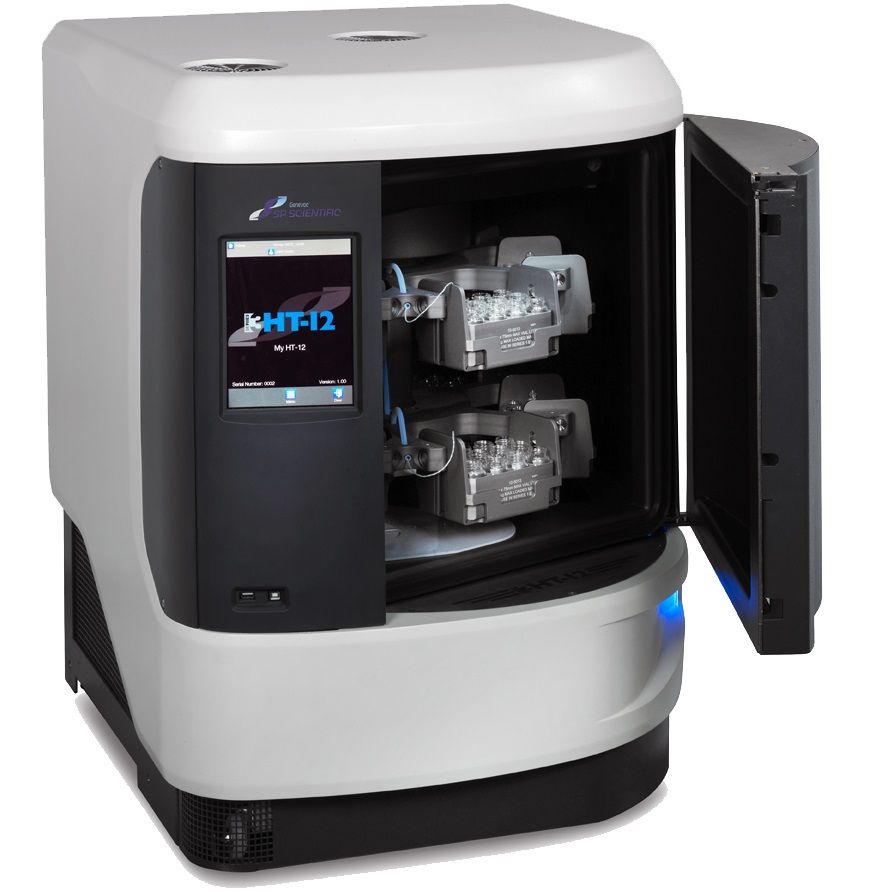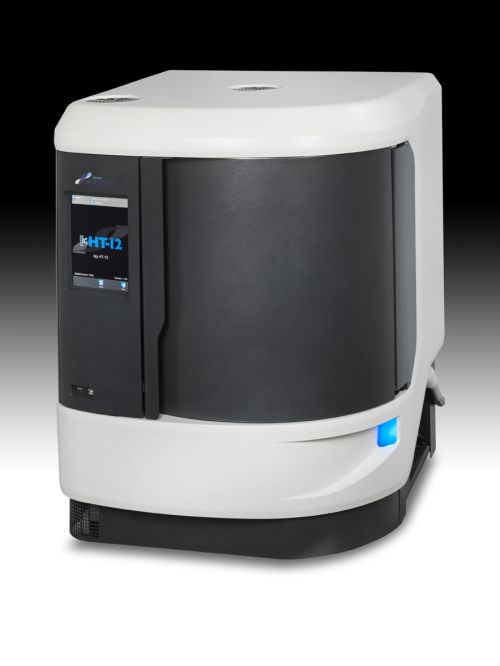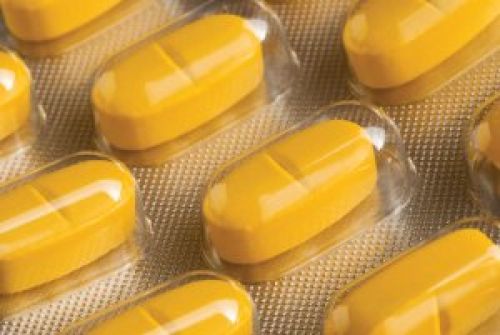HT-6 and HT-12 evaporators

The ultimate in solvent removal technology
Genevac HT series evaporators are the ideal solution for parallel evaporation bottlenecks in high throughput and production laboratories having high performance and high sample capacities.
System description
The all new Series 3 HT evaporator range from Genevac represents the ultimate in solvent removal technology. Incorporating new high performance vacuum pump, the latest touchscreen technology and a sleek ergonomic design makes optimising your evaporation processes effortless.
New intuitive touchscreen controls enhances monitoring and review of the whole evaporation process. For popular solvent removal protocols pre-set "Press & Go" methods makes operation easy and productive even for occasional users. Simplified manual and automatic programming means even the most complex multi-stage evaporation methods can be set-up and run quickly and easily.
Peace of mind comes as standard with patented temperature control and bumping prevention built in.
- ● High throughput evaporation
- ● High speed evaporation
- ● Fast lyophilisation capability
- ● New intuitive touchscreen control system for ultimate ease of use
- ● Integrated condenser meaning a smaller system footprint
- ● Front opening for easy access
- ● DriPure anti-bumping
Product Specialist

Mikael Alfredsson
031-709 81 86
Application Examples
Parallel Chemistry
Whether working in drug discovery, flavour or fragrence research, liquid chrystal synthesis or academic reaserch, Genevac systems are the ideal tool for use when performing parallel chemistry. When working with a single sample then a rotary evaporator is ideal, whereas, when you have multiple samples this would be a bottleneck. Spending time just watching a rotary evaporator is not very efficient!
- The main uses for Genevac systems are:
- ● Solvent exchange – removal of reaction solvents between stages
- ● Re-salt formation – removal of strong acids of bases when changing salt forms. Genevac have a special option for HCl resistance which enables the use of concentrated HCl – ideal for this purpose.
- ● Post Purification Handling – removing purification solvents following normal phase, reverse phase or chiral separation. Genevac also offer SampleGenie to enable a large volume to be dried directly into a small storage which eliminates the need to reformat samples from a flask into a vial. Reverse phase HPLC fractions may also be fast lyophilised in some Genevac systems.
- ● Compound logistics - transfer to and management of samples in storage conditions and systems, this is often done using DMSO, a notoriously difficult to evaporate high boiling point solvent.
- Depending on the number and nature of samples then one of several Genevac systems may be suitable – the EZ-2 and HT series are designed for working with smaller samples in plates, tubes and vials. When working with large volumes in flasks – then the Rocket evaporator is the most suitable, taking up to 6 flasks.
Useful Papers:
- Reactions involving HCl and their Evaporation - Dr Induka Abeysena, Genevac
- Development of an Evaporator for High Throughput Chemistry- Dr Tom Smith, GSK
- Surviving TFA - Application Note Parallel Dry-Loading of Synthesis Samples onto Silica for Analysis- Dr Nigel Vicker, Bath University Pharmacy Department
- Library Maintenance for the Smaller Pharma Company - poster by Dr Sally Hampton, Ferring Pharmaceuticals
- How to Evaporate High Boiling Point Solvents - Application Note
Contact us if you are interested in any of the above papers

Post Purification Sample Handling
- Normal Phase HPLC, SFC or Flash chromatography – removal of organic solvents is simple in a Genevac evaporator. Evaporation of Solvent Mixtures is safe when using Dri-Pure which eliminates the effects of bumping.
- Reverse Phase HPLC– evaporation of water and acetonitrile (or methanol) is the principal application of many Genevac systems. A multiple stage method has been developed to remove the organic solvent without freezing the water, remove the water, and then dry any remaining stubborn solvent. Alternatively, the LyoSpeed fast lyopilisation method can be used in Genevac HT series evaporators. Recent advances in condenser technology, in particular the high power -75°C cold trap available with the HT-8 or HT-12, have lead to significant advances in lyophilisation success rates.
Post Purification Handling following removal of purification solvents the sample typically needs to be reformatting from the fraction tubes or flask, into a small vial for compound storage. Genevac developed SampleGenie to enable a large volume to be dried (or lyophilised) directly into a small storage vial which eliminates the need to reformat samples from a flask or multiple tubes into a vial.
Depending on the number and nature of samples then one of several Genevac systems may be suitable – the EZ-2 and HT series are designed for working with smaller samples in plates, tubes and vials. When working with large volumes in flasks – then the Rocket evaporator is the most suitable, taking up to 6 flasks.
Useful Papers:
- Drying HPLC Fractions - applications note
- Fast Lyophilisation for HPLC Fractions - Dr Induka Abeysena & Rob Darrington
- Enhanced LyoSpeed™ with a -75°C Condenser - Rob Darrington
- Integration for High Throughput HPLC Purification - Paul de Fraine, Syngenta & Dr Mike Jones
- Drying Solvent Mixtures - applications note
- Evaluation of the Rocket Evaporation System - paper by Christine Prosser et al., UCB
- Automation of reverse phase HPLC fraction pooling, evaporation, and reformatting

Controlled Crystallisation
Chemists achieve crystalisation by many varied methods. Variation in temperature, solvent, head pressure, seeding method and evaporation rate can all have effects on the crystallisation process, influencing the form, shape and size of crystals formed. However for many methods used there is little control and often no reproducibility of these parameters. Such studies can also be time consuming and difficult to conduct
EXALT is a unique toolkit developed by Genevac and researchers in the field to assist with evaporative crystallisation studies in a number ways. By enabling a wide range of solvents to be evaporated at the same time and at the same slow rate, the EXALT system can deliver crystalline forms of a compound in a controlled and reproducible manner. It gives control to the operator by removing a number variables which are often present in current methods for crystallisation studies.
EXALT has been shown to be a useful tool for confirmation of stable forms, to create crystals from amorphous forms, to screen solvents for crystal production including production of seed crystals, and in co-crystal screening.
Environmental Analysis
When testing the water quality of a river, a point sample only provides a snap-shot of the situation, where as monitoring over a period of time will help present a better overall picture and can indicate where there is chronic build-up of a potentially harmful substance(s). Samples of tissue are often taken from fish living in the river are examined to determine the nature of any chemicals in the water. Another more recent approach is to use a virtual fish, a semi-permeable membrane device (SPMD) developed by the US Geological Survey. This is placed in the river for a period of time, and then any organic chemicals are extracted with solvent, concentrated and analysed as they would be from a fish.
Air quality can be monitored similarly by filtering air for a period of time, extracting the filter, and then concentrating and analysing whatever organic molecules may be trapped on the filter. This is a key activity in industrial environments where PAHs may be a risk factor for workers.
When concentrating samples the EZ-2 (small volumes) and Rocket (large volumes) are ideal tools for concentrating in the analytical laboratory. Coupled with SampleGenie they enhance analyte recovery, reduce inter-sample variability and free workers to do more productive tasks than monitoring a concentration system. SampleGenie enables large volume samples to be concentrated directly into an autosampler vial, eliminating the need to transfer the sample.
Useful Papers:
Improving Analysis of Airborne PAHs
Detectionand Quantification of Algal Toxins in Surface Water
Analysis of Glyphosate and its degradation Products in Surface Water

Metabolism & Toxicology Studies
Applications range from the relatively simple concentration or drying of solvent extracts from tissue samples to qualitatively analyse for the presence of a drug. Two studies using a miVac Concentrator focus on this work:
- Better Analasys of Insulin Analogues - Dr Catrin Goebel, Australian Sports Drug Testing Lab
- Detection of Diclofenac Residues in Wildlife - Dr Ngaio Richards, Anglia Ruskin University
More complex metabolic studies utilize labelled drug molecules which are fed to subjects. Samples are taken, extracted and separated via HPLC. Multiple samples are often collected in scintillant containing microtitre plates, such as the LumaPlate. These must be carefully dried before analysis via a luminescence reader such as a TopCount. If the plates are crudely dried the labelled molecule does not come into intimate contact with the scintillant providing a false reading. The Genevac EZ-2 and HT-4X have been shown to be excellent for this purpose.
Customers working with larger volumes have shown that SampleGenie is a useful tool to help automate their sample transfer process without adverse effect on sample recovery.
Useful Papers:
- Evaluation of the EZ-2 for Forensic Toxicology - Dr Eleanor Miller & Dr Simon Elliott, ROAR Forensics, UK. Evaluated the EZ-2 for use concentrating extracts from hair samples to detect alcohol and drugs of abuse metabolites entrained in the samples.
- Increasing Metabolite Recoveries in ADMET Studies - Dr Sophie Mcdougall, Sanofi Aventis. Studies showed that by using a Genevac HT-4 evaporator and Luma plates can increase the sensitivity and hence the recoveries as the extra gravitational force applied helps the sample mixture to dry as a tight pellet at the bottom of the well.
- Automation without Robotics - Peter Bennett, Drug Metabolism group at Servier ResearchEvaluation of SampleGenie™ in their laboratory
- Advances in Sample-prep for Metabolite Profiling - Dr Flavio Cinato, Nerviano MSTrials with EZ-2 showed that the optimal balance between speed and minimal compound degradation.
- Improving Productivity in Toxicology Screening - Rob Darrington, GenevacUsing a modern centrifugal evaporator like Genevac EZ-2 provides automation, user safety, reliability of the analysis and productivity
If you are interested in any of these papers please contatc us.

Natural Products Research
For basic botanical and biological research, the miVac concentrator range are the mainstay for those extracting and purifying DNA or proteins for genome and proteome research.
Genevac systems are widely used by researchers seeking to extract functional molecules from natural sources. A typical process would be to take a tissue (or micro-organism broth) sample and then perform a primary solvent extraction resulting in a large volume of crude extract. The crude extract is often concentrated, for which the Rocket Evaporator is ideal, before being fractionated to isolate each component. Fractionation may use a system such at the Sepbox, one, or two dimensional chromatography which produces many samples from one extract. These samples need to be evaporated before storage or analysis and may require lyophilisation. Genevac HT series evaporators are used for this purpose.
Useful Papers:
- High Throughput Natural Product Discovery - a paper by Stephen Pickrahn, IFF
- Rapid Evaporation Processes to Enhance Natural Product Extraction - by Dr John Hester, Principal R&D Engineer – Natural Product Repository Supervisor, University of Mississippi

